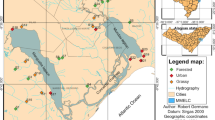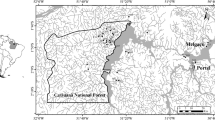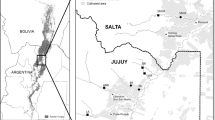Abstract
Few studies have assessed whether restored streams and riparian floodplains support reference communities of certain groups of freshwater organisms, such as turtles. This exploratory study compared turtle assemblages in six reference and six restored streams in the North Carolina Piedmont, which were assessed using standard trapping practices with baited hoop nets. We also quantified turtle-relevant habitat characteristics (structure, water quality, vegetation) through reach-scale surveys to assess potential differences in turtle composition. Turtle abundance at restored sites was more than twice that of references sites and trends existed in the distribution of turtle species, but neither abundance nor composition was found to be statistically different. Habitat characteristics that affect turtle communities were not equivalent between sites, with reference streams having higher canopy cover, and lower total phosphorus, dissolved oxygen and total suspended solids than restored streams. Mantel’s test and non-metric multidimensional scaling plots indicated that turtle composition was significantly correlated with habitat and vegetation, and that turtle communities were generally separated between restored and reference streams. These findings suggest a pattern that restored streams with riparian wetlands may provide more suitable habitat than reference streams for most southeastern Piedmont turtle species, but further studies are required to fully examine these patterns.


Similar content being viewed by others
References
Abramoff MD, Magelhaes PJ, Ram SJ (2004) Image processing with ImageJ. Biophotonics International 11:36–42
Anderson MJ, Crist TO, Chase JM, Vellend M, Inouye BD, Freestone AL, Sanders NJ, Cornell HV, Comita LS, Davies KF, Harrison SP, Kraft NJB, Stegen JC, Swenson NG (2011) Navigating the multiple meanings of β diversity: a roadmap for the practicing ecologist. Ecology Letters 14:19–28
Aresco MJ (2009) Environmental correlates of the abundances of three species of freshwater turtles in lakes of northern Florida. Copeia 2009:545–555
Attum O, Lee YM, Roe JH, Kingsbury BA (2008) Wetland complexes and upland-wetland linkages: landscape effects on the distribution of rare and common wetland reptiles. Journal of Zoology 275:245–251
Barrett K, Guyer C (2008) Differential responses of amphibians and reptiles in riparian and stream habitats to land use disturbances in western Georgia, USA. Biological Conservation 141:2290–2300
Bash JS, Ryan CM (2002) Stream restoration and enhancement projects: is anyone monitoring? Environmental Management 29:877–885
Bodie JR (2001) Stream and riparian management for freshwater turtles. Journal of Environmental Management 62:443–455
Bodie JR, Semlitsch RD (2000) Spatial and temporal use of floodplain habitats by lentic and lotic species of aquatic turtles. Oecologia 122:138–146
Bodie JR, Semlitsch RD, Renken RB (2000) Diversity and structure of turtle assemblages: associations with wetland characters across a floodplain landscape. Ecography 23:44–456
Bowers CF, Hanlin HG, Guynn DC, McLendon JP, Davis JR (2000) Herpetofaunal and vegetational characterization of a thermally-impacted stream at the beginning of restoration. Ecological Engineering 15:S101–S114
Brown T, Derting TL, Fairbanks K (2008) The effects of stream channelization and restoration on mammal species and habitat in riparian corridors. Journal of the Kentucky Academy of Sciences 69:37–49
Buhlmann K, Tuberville T, Gibbons W (2008) Turtles of the southeast. University of Georgia Press, Athens
Bulté G, Blouin-Demers G (2010) Estimating the energetic significance of basking behaviour in a temperate-zone turtle. Ecoscience 17:387–393
Cadi A, Joly P (2004) Impact of the introduction of the red-eared slider (Trachemys scripta elegans) on survival rates of the European pond turtle (Emys orbicularis). Biodiversity and Conservation 13:2511–2518
Cheung SM, Dudgeon D (2006) Quantifying the Asian turtle crisis: market surveys in southern China, 2000–2003. Aquatic Conservation: Marine and Freshwater Ecosystems 16:751–770
Conant R, Collins JT (1998) A field guide to reptiles and amphibians: eastern and central North America, 3rd edn. Houghton Mifflin Company, Boston
Conner CA, Douthit BA, Ryan AJ (2005) Descriptive ecology of a turtle assemblage in an urban landscape. American Midland Naturalist 153:428–435
Conover D, Klein J (2010) Changes in a restored wetland during 18 years of management (Ohio). Ecological Restoration 28:248–250
Convertino M, Baker KM, Vogel JT, Lu C, Suedel B, Linkov I (2013) Multi-criteria decision analysis to select metrics for design and monitoring of sustainable ecosystem restorations. Ecological Indicators 26:76–86
DeMeester DE, Richter DB (2010) Restoring restoration: removal of the invasive plant Microstegium vimineum from a North Carolina wetland. Biological Invasions 12:781–793
Doll BA, Grabow GL, Hall KR, Halley J, Harman WA, Jennings GD, Wise DE (2003) Stream restoration: a natural channel design handbook. NC Stream Restoration Institute, NC State University. 128 pp
DonnerWright DM, Bozek MA, Probst JR, Anderson EM (1999) Responses of turtle assemblage to environmental gradients in the St. Croix River in Minnesota and Wisconsin, USA. Canadian Journal of Zoology 77:989–1000
Ernst CH (1971) Population dynamics and activity cycles of Chrysemys picta in southeastern Pennsylvania. Journal of Herpetology 5:151–160
Ernst CH, Lovich JE (2009) Turtles of the United States and Canada. Johns Hopkins University, Baltimore
Ernst AG, Warren DR, Baldigo BP (2012) Natural-channel-design restorations that changed geomorphology have little effect on macroinvertebrate communities in headwater streams. Restoration Ecology 20:532–540
Ervin GN, Wetzel RG (2002) Influence of a dominant macrophyte, Juncus effusus on wetland plant species richness, diversity and community composition. Oecologia 130:626–636
Eskew EA, Price SJ, Dorcas ME (2010a) Survivorship and population densities of painted turtles (Chrysemys picta) in recently modified suburban landscapes. Chelonian Conservation and Biology 9:244–249
Eskew EA, Price SJ, Dorcas ME (2010b) Survival and recruitment of semi-aquatic turtles in an urbanized region. Urban Ecosystems 13:365–374
Failey EL, McCoy JC, Price SJ, Dorcas ME (2007) Ecology of turtles inhabiting golf course and farm ponds in the western Piedmont of North Carolina. Journal of the North Carolina Academy of Science 123:221–232
Gage MS, Spivak A, Paradise CJ (2004) Effects of land use and disturbance on benthic insects in headwater streams draining small watersheds north of Charlotte, NC. Southeastern Naturalist 3:345–358
Gibbs JP, Steen DA (2005) Trends in sex ratios of turtles in the United States: implications of road mortality. Conservation Biology 19:552–556
Glorioso BM, Vaughn AJ, Waddle JH (2010) The aquatic turtle assemblage inhabiting a highly altered landscape in southeast Missouri. Journal of Fish and Wildlife Management 1:161–168
Graham SP, Steen DA, Nelson KT, Durso AM, Maerz JC (2010) An overlooked hotspot? Rapid biodiversity assessment reveals a region of exceptional herpetofaunal richness in the southeastern United States. Southeastern Naturalist 9:19–34
Groffman PM, Bain DJ, Band LE, Belt KT, Brush GS, Grove JM, Pouyat RV, Yesilonis IC, Zipperer WC (2003) Down by the riverside: urban riparian ecology. Frontiers in Ecology and the Environment 1:315–321
Guzy JC, Price SJ, Dorcas ME (2013) The spatial configuration of greenspace affects semi-aquatic turtle occupancy and species richness in a suburban landscape. Landscape and Urban Planning 117:46–56
Harden LA, Price SJ, Dorcas ME (2009) Terrestrial activity and habitat selection of eastern mud turtles (Kinosternon subrubrum) in a fragmented landscape: implications for habitat management of golf courses and other suburban environments. Copeia 2009:78–84
Harper Ø, Harper DAT, Ryan PD (2001) PAST: paleontological statistics software package for education and data analysis. Palaeontologia Electronica 4(art. 4):9
Heinrich KK, Whiles MR, Roy C (2014) Cascading ecological responses to an in-stream restoration project in a midwestern river. Restoration Ecology 22:72–80
Hladyz S, Åbjörnsson K, Giller PS, Woodward G (2011) Impacts of an aggressive riparian invader on community structure and ecosystem functioning in stream food webs. Journal of Applied Ecology 48:443–452
Ho M, Richardson CJ (2013) A five year study of floristic succession in a restored urban wetland. Ecological Engineering 61:511–518
Hobbs RJ, Cramer VA (2008) Interventionist approaches for restoring and maintaining ecosystem function in the face of rapid environmental change. The Annual Review of Environment and Resources 33:39–61
Horwitz RJ, Johnson TE, Overbeck PF, O’Donnel TK, Hession WC, Sweeney BW (2008) Effects of riparian vegetation and watershed urbanization on fishes in streams of the mid-Atlantic Piedmont (USA). Journal of the American Water Resources Association 44:724–741
Iverson JB (1982) Biomass in turtle populations: a neglected subject. Oecologia 55:69–76
Jähnig SC, Lorenz AW, Hering D, Antons C, Sundermann A, Jedicke E, Haase P (2011) River restoration success: a question of perception. Ecological Applications 21:2007–2015
Joyal LA, McCollough M, Hunter ML (2001) Landscape ecology approaches to wetland species conservation: a case study of two turtle species in southern Maine. Conservation Biology 15:1755–1762
Kenkel NC, Orlóci L (1986) Applying metric and nonmetric multidimensional scaling to ecological studies: some new results. Ecology 67:919–928
LeGrand HE, McRae SE, Hall SP, Finnegan JT (2008) Natural heritage program list of the rare animal species of North Carolina. North Carolina Natural Heritage Program, NC Department of Environment and Natural Resources
Lewis GP, Mitchell JD, Andersen CB, Haney DC, Liao M, Sargent KA (2007) Urban influences on stream chemistry and biology in the Big Brushy Creek Watershed, South Carolina. Water, Air, and Soil Pollution 182:303–323
Meyers JM, Pike DA (2006) Herpetofaunal diversity of Alligator river national wildlife refuge, North Carolina. Southeastern Naturalist 5:235–252
Napton DE, Auch RF, Headley R, Taylor JL (2010) Land changes and their driving forces in the southeastern United States. Regional Environmental Change 10:37–53
North Carolina Division of Water Quality (2008) North Carolina Integrated Report Categories 4 and 5 (Impaired Waters List). Available via http://portal.ncdenr.org/c/document_library/get_file?uuid=9f453bf9-2053-4329-b943-6614bd4e709a&groupId=38364
Palmer WM, Braswell AL (1995) Reptiles of North Carolina. University of North Carolina Press, Chapel Hill
Palmer MA, Menninger HL, Bernhardt E (2009) River restoration, habitat heterogeneity and biodiversity: a failure of theory or practice? Freshwater Biology 55(Suppl 1):1–18
Pearse DE, Arndt AD, Valenzuela N, Miller BA, Cantarelli V, Sites JW (2006) Estimating population structure under non-equilibrium conditions in a conservation context: continent-wide population genetics of the giant Amazon River turtle, Podocnemis expansa (Chelonia; Podocnemididae). Molecular Ecology 15:985–1006
Price SJ, Guzy J, Witczak L, Dorcas ME (2013) Do ponds on golf courses provide suitable habitat for wetland-dependent animals in suburban areas? An assessment of turtle abundances. Journal of Herpetology 47:243–250
Raborn SW, Schramm H (2003) Fish assemblage response to recent mitigation of a channelized warmwater stream. River Research and Applications 19:289–301
Richardson JS (2004) Meeting the conflicting objectives of stream conservation and land use through riparian management: another balancing act. In: Scrimgeour GJ, Eisler G, McCulloch B, Silins U, Monita M (eds) Forest–Land–Fish Conference II — Ecosystem stewardship through collaboration. Proc. Forest–Land–Fish Conf. II, April 26–28, 2004, Edmonton, Alberta, pp. 1–6
Richardson CJ, King RS (2013) A primer on sampling plant communities in wetlands. In: DeLaune RD, Reddy KR, Richardson CJ, Megonigal JP (eds) Methods in biogeochemistry of wetlands. Soil Science Society of America, Inc, Madison, pp 197–224
Richardson CJ, Flanagan N, Ho M, Pahl J (2011) Integrated stream and wetland restoration: a watershed approach to improved water quality on the landscape. Ecological Engineering 37:25–39
Schnoonover JE, Lockaby BG (2006) Land cover impacts on stream nutrients and fecal coliform in the lower Piedmont of West Georgia. Journal of Hydrology 331:371–382
Seavy NE (2012) Developing a riparian bird index to communicate restoration success in Marin County, California. Ecological Restoration 30:157–160
Semlitsch RD, Bodie JR (2003) Biological criteria for buffer zones around wetlands and riparian habitats for amphibians and reptiles. Conservation Biology 17:1219–1228
Somma LA, Foster A, Fuller P (2014) Trachemys scripta elegans. USGS nonindigenous aquatic species database, Gainesville, FL. Available via http://nas.er.usgs.gov/queries/FactSheet.aspx?speciesID=1261. Accessed on 26 Sept 2014
Steen DA, Gibbs JP (2004) Effects of roads on the structure of freshwater turtle populations. Conservation Biology 18:1143–1148
Sudduth EB, Hassett BA, Cada P, Bernhardt ES (2011) Testing the field of dreams hypothesis: functional responses to urbanization and restoration in stream ecosystems. Ecological Applications 21:1972–1988
Tran SL, Moorhead DL, McKenna KC (2007) Habitat selection by native turtles in a Lake Erie Wetland, USA. American Midland Naturalist 158:16–28
US Army Corps of Engineers (2008) Regulatory guidance letter: No. 08–03
US Department of Agriculture (2014) Plants Database. Available via http://plants.usda.gov/. Accessed on 26 Sept 2014
US Office of the Federal Register (2008) Compensatory mitigation for losses of aquatic resources. Code of the Federal Regulations, Title 40, Part 230. U.S. Government Printing Office, Washington, D.C.
Walter RC, Merritts DJ (2008) Natural streams and the legacy of water-powered mills. Science 319:299–304
Wilson J, Kornilev Y, Anderson W, Connette G, Eskew E (2014a) Yellowbelly slider: Trachemys scripta. Davidson College. Available via http://www.bio.davidson.edu/projects/herpcons/herps_of_NC/turtles/Trascr/trascr.html. Accessed on 26 Sept 2014
Wilson J, Kornilev Y, Anderson W, Connette G, Eskew E (2014b) Eastern mud turtle: Kinosternon subrubrum. Davidson College. Available via http://www.bio.davidson.edu/projects/herpcons/herps_of_NC/turtles/Kinsub/kinsub.html. Accessed on 26 Sept 2014
Acknowledgments
The authors thank Mary Patricia Nowalk, Dean Urban, Wes Willis, Jean Still, Joshua Unghire, and Christopher Dudley. Funding provided by the Duke Wetland Center Endowment and the NC Clean Water Management Trust Fund.
Author information
Authors and Affiliations
Corresponding author
Electronic supplementary material
Below is the link to the electronic supplementary material.
ESM 1
(DOC 165 kb)
Rights and permissions
About this article
Cite this article
Dudley, M.P., Ho, M. & Richardson, C.J. Riparian Habitat Dissimilarities in Restored and Reference Streams are Associated with Differences in Turtle Communities in the Southeastern Piedmont. Wetlands 35, 147–157 (2015). https://doi.org/10.1007/s13157-014-0603-5
Received:
Accepted:
Published:
Issue Date:
DOI: https://doi.org/10.1007/s13157-014-0603-5




